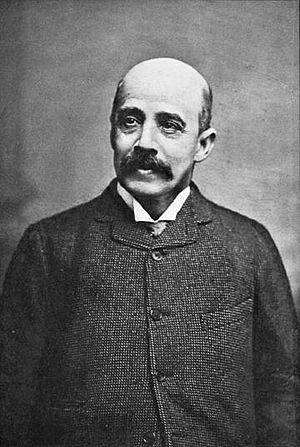Paul Du Chaillu facts for kids
Quick facts for kids
Paul Du Chaillu
|
|
|---|---|
 |
|
| Born | July 31, 1831/1835/1839 |
| Died | April 16/29, 1903 St. Petersburg, Russia
|
| Nationality | American |
| Occupation | Explorer, anthropologist |
| Known for | "Discovery" of gorilla, Pygmy people |
Paul Belloni Du Chaillu (born July 31, 1831, died April 29, 1903) was a French-American explorer and scientist. He was a zoologist, studying animals, and an anthropologist, studying human cultures. Paul Du Chaillu became famous in the 1860s. He was the first modern European to confirm that gorillas existed. He also met the Pygmy people in central Africa. Later in his life, he studied the early history of Scandinavia.
Contents
Paul Du Chaillu's Early Life
There are different ideas about when and where Paul Du Chaillu was born. Some say 1831, others 1835 or 1839. His birthday is usually listed as July 31. People often say he was born in Paris, France, or New Orleans, USA.
Paul Du Chaillu once said that the United States was his adopted country. He also called France his native land. A book from 1901-1902, which he helped write, says he was born in New Orleans in 1838. His grave marker says he was born in Louisiana in 1839.
A friend named Edward Clodd had a different story. Clodd believed Du Chaillu was born on a French island called Île Bourbon in the Indian Ocean. He also claimed Du Chaillu's mother was a mixed-race woman. In the 1800s, some scientists had unfair ideas about race. If Du Chaillu had mixed ancestry, it might have made people doubt his work. He might have tried to keep his family history private because of this.
When he was young, Paul Du Chaillu went to West Africa with his father. His father was a French trader. Paul learned a lot about the country, its animals, and the local people. He also learned their languages. He moved to the United States in 1852.
Exploring Africa
In 1855, the Academy of Natural Sciences in Philadelphia sent Paul Du Chaillu to Africa. He explored West Africa near the equator until 1859. He learned a lot about the Ogooué River and the Gabon area.
From 1856 to 1859, he saw many gorillas. Before this, Europeans only knew about gorillas from old stories or a few skeletons. Du Chaillu brought back dead gorilla specimens. He was seen as the first white European to have actually seen them alive.
Meeting the Pygmy People
From 1863 to 1865, Du Chaillu went on another trip. On this journey, he confirmed stories about a pygmy people living in the African forests. He sold the gorillas he hunted to the Natural History Museum in London. He also sold "cannibal skulls" to other museums. You can see some of his gorilla specimens at the Ipswich Museum in England.
He wrote books about his trips. The first was in 1861, called Explorations and Adventures in Equatorial Africa. It talked about the people, their customs, and hunting animals like gorillas. His second book, A Journey to Ashango-land, came out in 1867. While in Ashango Land in 1865, the Apingi tribe chose him as their King. He wrote another book, The Country of the Dwarfs, in 1872.
Paul Du Chaillu became very popular. He gave many talks in New York, London, and Paris. At first, some people doubted his stories. But later, his accounts were accepted. Some wondered if he used local hunting stories in his own adventures.
Discovering New Animals
Besides gorillas, Du Chaillu found and described many new animal species. He was the first to scientifically describe the giant otter shrew. He also collected the first examples of the southern needle-clawed bushbaby, the hammer-headed bat, and the African pygmy squirrel. These are all animals from West Africa. Even though he didn't mainly collect birds, he found examples for 39 different bird species. He also collected the first examples of a frog called Amnirana albolabris from Gabon.
Exploring Northern Europe
After living in America for some years, Paul Du Chaillu wrote several books for young people. These books were based on his adventures in Africa. Then, he became interested in northern Europe.
In 1871, he visited northern Norway. For the next five years, he studied the customs and old traditions in Sweden, Norway, Lapland, and Northern Finland. In 1881, he published a two-volume book called The Land of the Midnight Sun. It described his summer and winter journeys there.
Studying the Vikings
His 1889 book, The Viking Age, also had two volumes. This book was a big study of the early history and customs of the people who were ancestors of English-speaking nations. He worked on it for eight and a half years. He carefully read hundreds of old stories called Sagas. These Sagas described the lives of people in Scandinavia from the Stone Age to the Middle Ages.
This important work showed how important the Norse people (from Norway, Sweden, and Denmark) were. They greatly influenced the culture of the British Isles between the 5th and 11th centuries. This idea was new at the time and some people made fun of it. Today, this book is very special to collectors. In 1900, he also published The Land of the Long Night.
Paul Du Chaillu's Personal Life
Paul Du Chaillu was friends with Edward Clodd. He also played cricket with author J. M. Barrie on an amateur team called the "Allahakbarries."
Paul Du Chaillu died in St. Petersburg, Russia. He was there for research on Scandinavian peoples when he had a stroke. He is buried at Woodlawn Cemetery in the Bronx, New York City.
Images for kids
See also
 In Spanish: Paul du Chaillu para niños
In Spanish: Paul du Chaillu para niños




